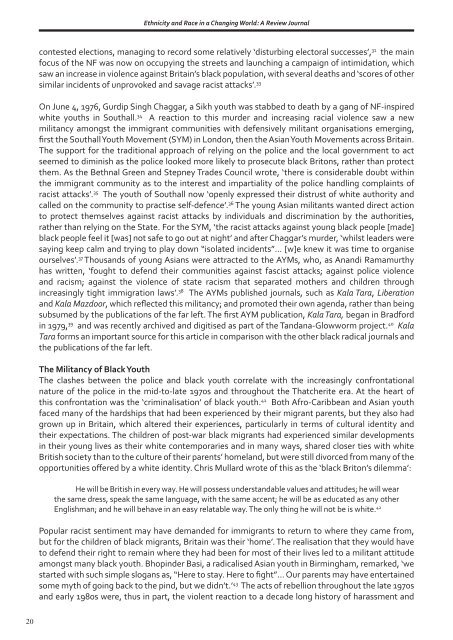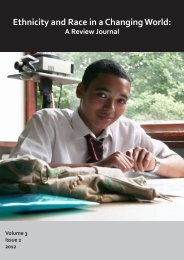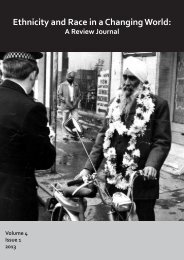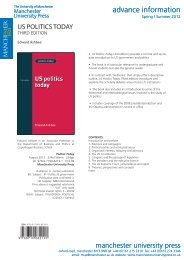Ethnicity and Race in a Changing World
Volume 2, Issue 1, 2010 - Manchester University Press
Volume 2, Issue 1, 2010 - Manchester University Press
- No tags were found...
Create successful ePaper yourself
Turn your PDF publications into a flip-book with our unique Google optimized e-Paper software.
<strong>Ethnicity</strong> <strong>and</strong> <strong>Race</strong> <strong>in</strong> a Chang<strong>in</strong>g <strong>World</strong>: A Review Journalcontested elections, manag<strong>in</strong>g to record some relatively ‘disturb<strong>in</strong>g electoral successes’, 31 the ma<strong>in</strong>focus of the NF was now on occupy<strong>in</strong>g the streets <strong>and</strong> launch<strong>in</strong>g a campaign of <strong>in</strong>timidation, whichsaw an <strong>in</strong>crease <strong>in</strong> violence aga<strong>in</strong>st Brita<strong>in</strong>’s black population, with several deaths <strong>and</strong> ‘scores of othersimilar <strong>in</strong>cidents of unprovoked <strong>and</strong> savage racist attacks’. 33On June 4, 1976, Gurdip S<strong>in</strong>gh Chaggar, a Sikh youth was stabbed to death by a gang of NF-<strong>in</strong>spiredwhite youths <strong>in</strong> Southall. 34 A reaction to this murder <strong>and</strong> <strong>in</strong>creas<strong>in</strong>g racial violence saw a newmilitancy amongst the immigrant communities with defensively militant organisations emerg<strong>in</strong>g,first the Southall Youth Movement (SYM) <strong>in</strong> London, then the Asian Youth Movements across Brita<strong>in</strong>.The support for the traditional approach of rely<strong>in</strong>g on the police <strong>and</strong> the local government to actseemed to dim<strong>in</strong>ish as the police looked more likely to prosecute black Britons, rather than protectthem. As the Bethnal Green <strong>and</strong> Stepney Trades Council wrote, ‘there is considerable doubt with<strong>in</strong>the immigrant community as to the <strong>in</strong>terest <strong>and</strong> impartiality of the police h<strong>and</strong>l<strong>in</strong>g compla<strong>in</strong>ts ofracist attacks’. 35 The youth of Southall now ‘openly expressed their distrust of white authority <strong>and</strong>called on the community to practise self-defence’. 36 The young Asian militants wanted direct actionto protect themselves aga<strong>in</strong>st racist attacks by <strong>in</strong>dividuals <strong>and</strong> discrim<strong>in</strong>ation by the authorities,rather than rely<strong>in</strong>g on the State. For the SYM, ‘the racist attacks aga<strong>in</strong>st young black people [made]black people feel it [was] not safe to go out at night’ <strong>and</strong> after Chaggar’s murder, ‘whilst leaders weresay<strong>in</strong>g keep calm <strong>and</strong> try<strong>in</strong>g to play down “isolated <strong>in</strong>cidents”… [w]e knew it was time to organiseourselves’. 37 Thous<strong>and</strong>s of young Asians were attracted to the AYMs, who, as An<strong>and</strong>i Ramamurthyhas written, ‘fought to defend their communities aga<strong>in</strong>st fascist attacks; aga<strong>in</strong>st police violence<strong>and</strong> racism; aga<strong>in</strong>st the violence of state racism that separated mothers <strong>and</strong> children through<strong>in</strong>creas<strong>in</strong>gly tight immigration laws’. 38 The AYMs published journals, such as Kala Tara, Liberation<strong>and</strong> Kala Mazdoor, which reflected this militancy; <strong>and</strong> promoted their own agenda, rather than be<strong>in</strong>gsubsumed by the publications of the far left. The first AYM publication, Kala Tara, began <strong>in</strong> Bradford<strong>in</strong> 1979, 39 <strong>and</strong> was recently archived <strong>and</strong> digitised as part of the T<strong>and</strong>ana-Glowworm project. 40 KalaTara forms an important source for this article <strong>in</strong> comparison with the other black radical journals <strong>and</strong>the publications of the far left.The Militancy of Black YouthThe clashes between the police <strong>and</strong> black youth correlate with the <strong>in</strong>creas<strong>in</strong>gly confrontationalnature of the police <strong>in</strong> the mid-to-late 1970s <strong>and</strong> throughout the Thatcherite era. At the heart ofthis confrontation was the ‘crim<strong>in</strong>alisation’ of black youth. 41 Both Afro-Caribbean <strong>and</strong> Asian youthfaced many of the hardships that had been experienced by their migrant parents, but they also hadgrown up <strong>in</strong> Brita<strong>in</strong>, which altered their experiences, particularly <strong>in</strong> terms of cultural identity <strong>and</strong>their expectations. The children of post-war black migrants had experienced similar developments<strong>in</strong> their young lives as their white contemporaries <strong>and</strong> <strong>in</strong> many ways, shared closer ties with whiteBritish society than to the culture of their parents’ homel<strong>and</strong>, but were still divorced from many of theopportunities offered by a white identity. Chris Mullard wrote of this as the ‘black Briton’s dilemma’:He will be British <strong>in</strong> every way. He will possess underst<strong>and</strong>able values <strong>and</strong> attitudes; he will wearthe same dress, speak the same language, with the same accent; he will be as educated as any otherEnglishman; <strong>and</strong> he will behave <strong>in</strong> an easy relatable way. The only th<strong>in</strong>g he will not be is white. 42Popular racist sentiment may have dem<strong>and</strong>ed for immigrants to return to where they came from,but for the children of black migrants, Brita<strong>in</strong> was their ‘home’. The realisation that they would haveto defend their right to rema<strong>in</strong> where they had been for most of their lives led to a militant attitudeamongst many black youth. Bhop<strong>in</strong>der Basi, a radicalised Asian youth <strong>in</strong> Birm<strong>in</strong>gham, remarked, ‘westarted with such simple slogans as, “Here to stay. Here to fight”… Our parents may have enterta<strong>in</strong>edsome myth of go<strong>in</strong>g back to the p<strong>in</strong>d, but we didn’t.’ 43 The acts of rebellion throughout the late 1970s<strong>and</strong> early 1980s were, thus <strong>in</strong> part, the violent reaction to a decade long history of harassment <strong>and</strong>20






